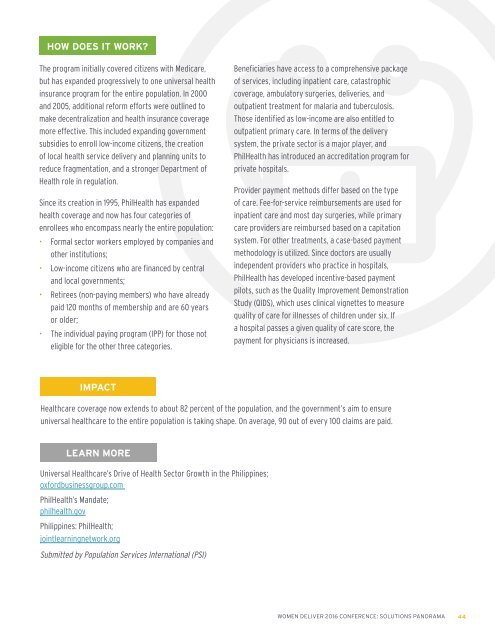Solutions Panorama
A collection of 100 programs, initiatives, and strategies that were shared at the Women Deliver 2016 Conference.
A collection of 100 programs, initiatives, and strategies that were shared at the Women Deliver 2016 Conference.
You also want an ePaper? Increase the reach of your titles
YUMPU automatically turns print PDFs into web optimized ePapers that Google loves.
HOW DOES IT WORK?<br />
The program initially covered citizens with Medicare,<br />
but has expanded progressively to one universal health<br />
insurance program for the entire population. In 2000<br />
and 2005, additional reform efforts were outlined to<br />
make decentralization and health insurance coverage<br />
more effective. This included expanding government<br />
subsidies to enroll low-income citizens, the creation<br />
of local health service delivery and planning units to<br />
reduce fragmentation, and a stronger Department of<br />
Health role in regulation.<br />
Since its creation in 1995, PhilHealth has expanded<br />
health coverage and now has four categories of<br />
enrollees who encompass nearly the entire population:<br />
• Formal sector workers employed by companies and<br />
other institutions;<br />
• Low-income citizens who are financed by central<br />
and local governments;<br />
• Retirees (non-paying members) who have already<br />
paid 120 months of membership and are 60 years<br />
or older;<br />
• The individual paying program (IPP) for those not<br />
eligible for the other three categories.<br />
Beneficiaries have access to a comprehensive package<br />
of services, including inpatient care, catastrophic<br />
coverage, ambulatory surgeries, deliveries, and<br />
outpatient treatment for malaria and tuberculosis.<br />
Those identified as low-income are also entitled to<br />
outpatient primary care. In terms of the delivery<br />
system, the private sector is a major player, and<br />
PhilHealth has introduced an accreditation program for<br />
private hospitals.<br />
Provider payment methods differ based on the type<br />
of care. Fee-for-service reimbursements are used for<br />
inpatient care and most day surgeries, while primary<br />
care providers are reimbursed based on a capitation<br />
system. For other treatments, a case-based payment<br />
methodology is utilized. Since doctors are usually<br />
independent providers who practice in hospitals,<br />
PhilHealth has developed incentive-based payment<br />
pilots, such as the Quality Improvement Demonstration<br />
Study (QIDS), which uses clinical vignettes to measure<br />
quality of care for illnesses of children under six. If<br />
a hospital passes a given quality of care score, the<br />
payment for physicians is increased.<br />
IMPACT<br />
Healthcare coverage now extends to about 82 percent of the population, and the government’s aim to ensure<br />
universal healthcare to the entire population is taking shape. On average, 90 out of every 100 claims are paid.<br />
LEARN MORE<br />
Universal Healthcare’s Drive of Health Sector Growth in the Philippines;<br />
oxfordbusinessgroup.com<br />
PhilHealth’s Mandate;<br />
philhealth.gov<br />
Philippines: PhilHealth;<br />
jointlearningnetwork.org<br />
Submitted by Population Services International (PSI)<br />
WOMEN DELIVER 2016 CONFERENCE: SOLUTIONS PANORAMA 44



